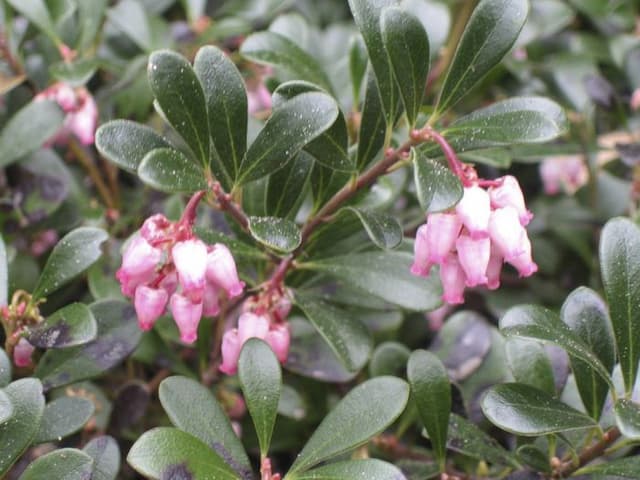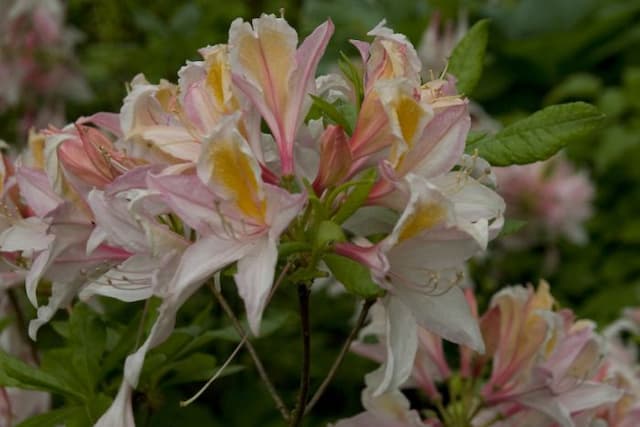Blueberry Vaccinium corymbosum 'Duke' (F)

ABOUT
The 'Duke' blueberry is recognized for its distinctive bushy appearance, typically presenting dense foliage. The leaves are broad and elliptical, exhibiting an attractive green color during the growing season. As the plant matures through the season, white, bell-shaped flowers bloom, adding a decorative touch to the bush. These flowers ultimately give way to the fruit for which the plant is most well-known: clusters of blueberries. The berries themselves have a dusty blue hue and are both plump and firm, each berry encasing a refreshing, mildly sweet flavor with a hint of tartness. In fall, the foliage often transforms, taking on brilliant red and orange hues, providing a striking contrast to the cooling temperatures and shorter days. Despite changing seasons, 'Duke' blueberry maintains an appealing presence in the garden, attracting not only human admirers but also birds and beneficial insects that come to feast on the ripe berries or seek habitat within the leafy branches.
About this plant
 Names
NamesSynonyms
Duke Blueberry, Northern Highbush Blueberry, High Bush Blueberry
Common names
Vaccinium corymbosum 'Duke' (F).
 Toxicity
ToxicityTo humans
The most common common name for Vaccinium corymbosum 'Duke' is the highbush blueberry. Highbush blueberry plants, including the 'Duke' cultivar, are not generally considered toxic to humans. In fact, blueberries are widely consumed and are known for their nutritional benefits, including high levels of antioxidants. There is typically no concern with eating the berries unless one has a specific allergy to blueberries themselves, which could result in allergic reactions with symptoms that may include itching, swelling, and difficulty breathing. However, it is always important to consume plants, including highbush blueberries, that are free of pesticides and other contaminants.
To pets
The most common common name for Vaccinium corymbosum 'Duke' is the highbush blueberry. Highbush blueberry plants are generally recognized as safe for pets, including dogs and cats. The berries themselves are often recommended as a healthy, low-calorie treat for pets. There is no known toxicity from pets ingesting the blueberries or plant parts of the highbush blueberry. However, it's always important to monitor your pets and introduce new foods gradually to ensure they don't have an allergic reaction or digestive upset.
 Characteristics
CharacteristicsLife cycle
Perennials
Foliage type
Deciduous
Color of leaves
Green
Flower color
White
Height
6 feet (1.83 meters)
Spread
6 feet (1.83 meters)
Plant type
Shrub
Hardiness zones
5
Native area
North America
Benefits
 General Benefits
General Benefits- High Yield: Early ripening cultivar that produces abundant fruit crops.
- Attractive Ornamental: Features showy white flowers in spring and vibrant foliage in fall.
- Pollinator Friendly: Attracts bees and other pollinators, which are essential for fruit production.
- Erosion Control: The plant's root system helps stabilize soil and prevent erosion.
- Edible Fruit: Provides delicious blueberries that can be eaten fresh or used in a variety of culinary dishes.
- Wildlife Habitat: Offers food and shelter for birds and other wildlife species.
- Adaptability: Tolerant of a variety of soil conditions, though prefers acidic soils.
- Low Maintenance: Once established, requires minimal care aside from pruning and occasional fertilization.
- Extended Harvest: 'Duke' has a relatively long fruiting season, providing berries over a longer period.
- Frost Tolerance: Exhibits good tolerance to spring frosts, which can protect the fruit crop.
 Medical Properties
Medical Properties- Antioxidant activity: Blueberries contain high levels of anthocyanins, which are compounds with potent antioxidant properties that may help protect cells from damage.
- Heart health: Regular consumption of blueberries has been associated with reduced risk factors for cardiovascular disease, such as lowered LDL cholesterol levels and improved blood pressure.
- Blood sugar regulation: Blueberries have a low glycemic index and may help in maintaining healthy blood sugar levels, which is beneficial for people with diabetes or at risk of the disease.
- Cognitive function: Some studies suggest that blueberries can improve memory and cognitive functions, potentially having a role in delaying age-related decline in mental health.
- Cancer prevention: There is preliminary evidence that the phytochemicals found in blueberries might contribute to reducing oxidative stress and inflammation, which are linked to a reduced risk of certain types of cancer.
- Urinary tract health: Blueberries, like cranberries, contain substances that can prevent the binding of bacteria to the lining of the urinary tract, which may help in preventing urinary tract infections (UTIs).
- Digestive health: The fiber content in blueberries helps to maintain gastrointestinal regularity and health.
- Vision health: The vitamin and antioxidant content in blueberries may support eye health, including slowing down the progression of conditions like age-related macular degeneration.
- Anti-inflammatory properties: The compounds in blueberries can exhibit anti-inflammatory effects, which might aid in reducing the impact of various chronic inflammatory diseases.
- Weight management: Due to their fiber content and low-calorie profile, blueberries can be a part of a healthy diet aimed at maintaining an appropriate weight.
 Air-purifying Qualities
Air-purifying QualitiesThis plant is not specifically known for air purifying qualities.
 Other Uses
Other Uses- Wildlife Habitat: Blueberry bushes can provide shelter and nesting sites for various bird species, as the dense foliage offers protection and a secure place to raise their young.
- Photography Subject: The blueberry's delicate flowers, vibrant berries, and vivid fall foliage make it a favorite subject for nature photographers seeking to capture the beauty of the plant throughout the seasons.
- Natural Dyes: The berries can be used to produce natural dyes for textiles and crafts, offering a range of blues and purples that can give fabric a unique look.
- Decoration: Both the flowers and berries of the blueberry plant can be used in floral arrangements or as garnishes on food dishes for aesthetic enhancement.
- Educational Resource: Blueberry plants can be used in educational settings such as schools or botanical gardens to teach children about plant biology, pollination, and fruit development.
- Culinary Experiments: Blueberry leaves and stems can be used to infuse teas or concoct vinegars, providing subtle flavorings in culinary creations.
- Erosion Control: The root system of the blueberry bush helps stabilize soil, making it useful for planting on slopes or areas prone to erosion.
- Bonsai: With its small leaves and potential for attractive shaping, blueberry plants can be trained as bonsai trees, providing an intriguing and edible twist to this traditional Japanese art form.
- Fruit Picking Attraction: Blueberry farms often serve as agro-tourism destinations where visitors can pick their own berries, experiencing the hands-on agricultural process in a scenic environment.
- Biomonitoring: Blueberry plants can be used as indicators of environmental health, as their growth and fruiting can be affected by soil conditions, air quality, and climate, thus signaling ecological changes.
Interesting Facts
 Feng Shui
Feng ShuiThe Blueberry is not used in Feng Shui practice.
 Zodiac Sign Compitability
Zodiac Sign CompitabilityThe Blueberry is not used in astrology practice.
 Plant Symbolism
Plant Symbolism- Perseverance: The blueberry, being a hardy plant that can survive in harsh conditions, symbolizes the ability to endure and persevere through difficult circumstances.
- Health and Wellbeing: Blueberries are known for their nutritious value and anti-oxidant properties, making them a symbol for good health and longevity.
- Abundance: A blueberry bush produces a large number of berries, symbolizing abundance and plenty.
- Nature's Bounty: As a wild-growing fruit, blueberries represent the gifts of the natural world and the generosity of the Earth.
- Protection: In some native cultures, blueberries are believed to have protective qualities, warding off negativity and harm.
- Gratitude: The blueberry season is often celebrated with gratitude for the harvest, symbolizing thankfulness for the richness of nature's provision.
 Water
WaterBlueberry plants, including the 'Duke' variety, prefer evenly moist soil and require regular watering, especially during dry spells. Typically, watering once a week with about 1 to 2 inches (0.62 to 1.24 gallons) of water is adequate. The key is to keep the soil moist but not waterlogged. During hot or windy weather, you might need to water more frequently. Use a soaker hose or drip irrigation to deliver water directly to the roots and minimize waste.
 Light
LightBlueberry plants, such as the 'Duke' blueberry, thrive in full sun to partial shade. They need at least 6 to 8 hours of sunlight per day to produce the best fruit. The ideal spot for 'Duke' blueberries is an area with bright, direct sunlight for most of the day, but with some protection from the intense, late afternoon sun.
 Temperature
TemperatureThe 'Duke' blueberry prefers moderate temperatures and has a chilling requirement to properly break dormancy. The plant can survive winter temperatures down to about -20 degrees Fahrenheit. The ideal growing temperature range during the growing season is between 60 to 75 degrees Fahrenheit, but it can withstand summers that reach up to 85 degrees Fahrenheit.
 Pruning
PruningPruning is important for the 'Duke' blueberry to maintain plant health, encourage strong growth, and support fruit production. Prune the plants during the dormant season, in late winter or early spring, before new growth begins. Remove dead or diseased branches, thin out crowded areas, and cut back older stems to encourage vigorous new growth. Prune about once a year, focusing on shaping the plant and improving air circulation.
 Cleaning
CleaningAs needed
 Soil
SoilThe best soil mix for Duke Blueberry, which is the most common name for Vaccinium corymbosum 'Duke', is one that is well-draining, rich in organic matter and acidic with a pH between 4.5 and 5.5. A mix of peat moss, sand, and loamy soil often works well for providing the necessary conditions for optimal growth.
 Repotting
RepottingDuke Blueberry typically does not need to be repotted frequently as it is usually grown outdoors. However, if grown in a container, it should be repotted every 2 to 3 years to prevent root-bound conditions and to replenish the soil with a fresh, acidic mix.
 Humidity & Misting
Humidity & MistingDuke Blueberry thrives best in an environment with moderate humidity. While it can tolerate some variation, maintaining a humidity level around 50-60% is generally beneficial for the plant's growth and health.
 Suitable locations
Suitable locationsIndoor
Use acidic soil, maintain humidity, provide full light.
Outdoor
Plant in acidic soil, full sun, protect from harsh winds.
Hardiness zone
3-7 USDA
 Life cycle
Life cycleThe Duke Blueberry (Vaccinium corymbosum 'Duke') begins its life cycle as a seed, which, once sown and in suitable conditions, germinates to emerge as a seedling. As the seedling grows, it develops into a juvenile plant, which forms its root system and foliage but does not yet bear fruit. After a few years, usually two to three, the plant reaches maturity and enters its productive phase, blooming in spring with white bell-shaped flowers that attract pollinators. These flowers are then pollinated, leading to the development of green berries that ripen to a deep blue by mid to late summer, when they are harvested. The plant then goes into a period of dormancy in the fall and winter, conserving energy and resources until the next growing season. This cycle repeats annually, with the blueberry bushes living and producing fruit for many years, often decades, with proper care and maintenance.
 Propogation
PropogationPropogation time
Spring-Early Summer
The most popular method for propagating the 'Duke' blueberry plant, a cultivar of Vaccinium corymbosum, is through softwood cuttings. This technique is typically carried out in late spring or early summer when the plant's new growth is still tender and flexible. Gardeners cut a 4- to 6-inch length of stem that includes several leaves, dipping the cut end into a rooting hormone to encourage root development. The cutting is then planted in a well-draining soil mix, ensuring at least two leaf nodes are buried. The pot is kept under high humidity conditions, often by covering it with a plastic bag or placing it in a greenhouse environment, and in indirect light. Roots usually form within a few weeks, after which the new blueberry plant can eventually be transplanted to a more permanent location in the garden.









